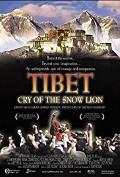
Directed by
Tom Peosay
103 minutes
Rated M
Reviewed by
Sharon Hurst


Tibet: Cry of the Snow Lion
Synopsis: Since 1949, China has been attempting to "peacefully liberate" Tibet. The result has been the death of 1.2 million Tibetans, which is nearly one-sixth of the entire population. This heart-wrenching documentary gives an impressive historical overview of Tibet, along with engrossing interviews and rare unseen archival footage.Ten years in the making, this film is the result of nine trips to Tibet by the director. Structurally, the film moves about in non-linear time, with the opening scenes being those of stunning Himalayan scenery providing the backdrop to a pair of young American tourists caught up in the middle of Tibetan demonstrations against the Chinese in 1987. This is supported by ghastly scenes of Chinese brutality, graphic recounting by tortured monks and nuns, the story of one particularly heroic monk, and images of the Dalai Lama. Thus in the opening sequences of the film, the director unobtrusively acquaints us with his main themes and then takes us, almost National Geographic style, into the history of this beautiful country often known as the "altar of the earth". The cinematography (by Peosay who was also the producer)is ravishing, and we are treated to fascinating interviews with elderly Tibetans reflecting upon their youth and the traditions and spirituality that are seared into their identity. After a brief history of Buddhism, the Dalai Lama, and Sino-Tibetan relations, with commentary by several renowned scholars, the film again plunges us into confronting images of present day Lhasa, the capital, with its 658 brothels and its encroaching capitalist institutions.
The filmmakers also give the official Chinese position some airplay; namely that Tibet is nothing more than an outpost of China, and so relocating Chinese there and encouraging Chinese enterprise is perfectly acceptable. As a consequence, Peosay claims the Tibetan identity is being wiped out, the people are fast becoming unemployed second-class citizens and as the film depicts, a deep level of oppression and brutality towards dissenters remains. Again, in time shifts, we see the Mao Tse Tung era in China, and learn of the devastation wreaked not only on Tibet and its monasteries but also on the Chinese people. The film raises the issue of whether progress can only be made in the Tibet situation when basic human rights issues in China are also addressed.
A recurring motif in the film is the flickering of lamps and the creation of the mandala (wheel of life). This is combined with inspiring footage of the Dalai Lama and the thousands of Tibetans who escape each year to be with him in Dharamsala, India, keeping alive Tibetan language and culture, and, above all, hope for national independence. The horror of the Tibetan's situation is regularly intercut with interviewees espousing non-violent Buddhist beliefs, a contrast that is central to why the Tibetan struggle is so inspiring. Just as Buddhism has a circular theory of life and death, so the film turns in many circles. Again near its conclusion come more appalling images of the sacred city of Lhasa, with giant Santas and Chinese children in dodg'em cars, along with the Dalai Lama's former residence now transformed into a tourist park.
Some documentaries derive their strength from a clearly-presented wealth of information; others chronicle situations so confronting that they are emotionally moving. Tibet: Cry of the Snow Lion does both. Not only is the history of this remarkable country presented in an accessible and interesting way, but the emotional impact of the content, together with the inspiring nature of the Tibetans, combine to pack a powerful emotional wallop, with an unforgettable closing scene which brings the struggle into the modern Western world.
Want something different?





